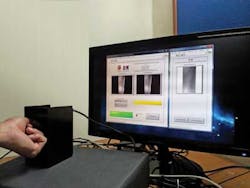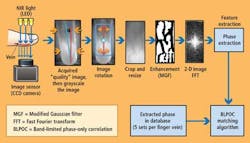BIOMETRICS: Biometric identification system leverages Fourier analysis
A number of different techniques exist to secure buildings, computers, and banking services. Personalized security cards and passwords are most commonly used in relatively low-risk applications, whereasbiometric methods that employ fingerprint, face, and iris recognition are often used where a higher level of security is required.
Iris recognition systems have been shown to provide the highest accuracy of these biometric methods, but they are often expensive. Realizing this, Lau Wei Cheang, Tan Pin Yang, and Bakhtiar Affendi Bin Rosdi, PhD, at the Engineering Campus at the Universiti Sains Malaysia (www.usm.my) have developed a biometric identification system that can identify and validate the veins within the finger of a human being (see Fig. 1).
This method, says Wei Cheang, offers high security and is almost impossible to counterfeit because veins are located beneath the surface of the skin. As with other biometric identification systems, the finger-vein system first requires an image of the fingerprint to be digitized and stored in a database.
First, a finger is inserted into the system where it is back-illuminated by near-infrared (NIR) illumination. Since hemoglobin in the blood absorbs this NIR light, the veins will appear darker than the surrounding muscle of the finger. A CCD camera captures an image of the light as it passes though the finger. The image is then transferred over an Ethernet interface to a single-board RIO-9632 processor fromNational Instruments (www.ni.com).
Since the image may be slightly rotated as it is captured, it must then be rotated again so each image will appear at a known angle. Despite this correction, some vertical or horizontal image translation may still exist. Thus, the system digitizes five vein images that increase system stability and accuracy, says Wei Cheang.
Because the system must also accommodate fingers with different skin types and thicknesses, it employs a feedback control to adjust the intensity of the IR LED so the acquired image achieves the best contrast. This automated control system is implemented using the field-programmable gate array (FPGA) on the RIO-9632 single-board processor. This imaging method prevents skin thickness from affecting the biometric system accuracy.
To further increase accuracy, vein patterns in the finger must appear in high contrast to muscle. A modifiedGaussian filter is used to enhance the resized image so vein patterns appear black and the muscle appears white.
Rather than simply digitize the images into a database and then use the database to compare known and newly digitized fingerprints, the system uses a band-limited, phase-only correlation (BLPOC) method to compare known and unknown images (see Fig. 2).
After images are digitized and enhanced, afast Fourier transform (FFT) is applied to each one. The phase of the resulting complex image is then used for the BLPOC algorithm. This eliminates any rotation error that may occur between images and is more robust to image noise than phase-only correlation methods. Wei Cheang chose NI's LabVIEW to implement the algorithms because it provides image conversion, image enhancement, FFT, and inverse FFT operators.
When the matching phase score generated by the system is greater than a threshold, known and unknown images are validated. If the matching score is less than the threshold score, the system identifies the finger as unknown. In operation, the total average time taken from cropping an image to matching it to those stored in the database is 0.5 sec. Tests have shown that the system performs with 98.93% accuracy.


